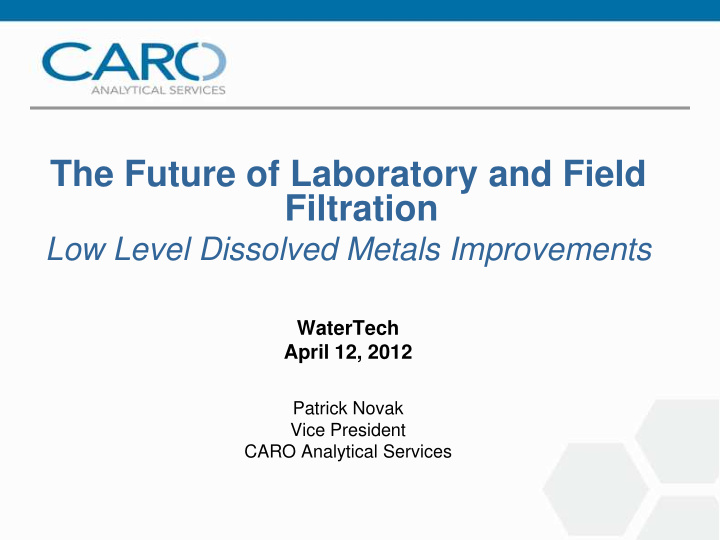



The Future of Laboratory and Field Filtration Low Level Dissolved Metals Improvements WaterTech April 12, 2012 Patrick Novak Vice President CARO Analytical Services
Outline 1. Challenge • Why do we need such low metals data? 2. Solutions • Instrumentation & Processes • Filtration 3. Evaluation of Filtration Devices • Approach • Findings/Data • Recommendation
30 Second Biography • Environmental Laboratory – Chemistry, Microbiology, Aquatic Toxicity • Locations – Richmond, Kelowna & Edmonton • People – 50+ Staff – 10+ Professional Chemists – Industry Involvement: CALA, BCELTAC, ACPBC & EMA
Laboratory Perception We are not CSI!
The Challenge Why do we need such low metals data? 1. New Regulations/Environmental Protection • Example: “ Water & Air Resource Protection Guidelines for Mine Proponents & Operators – Baseline Monitoring ” . Draft BCMOE, 2009 2. Clients Requests 3. Market Competition “ Order of Magnitude ” DL improvements needed
The Solution - Instrumentation Agilent ’ s 7700 Series ICP-MS • Octopole Reaction System • Interference Removal • High Matrix Introduction • Significantly Lower DLs
The Solution – Processes Other Issues Amplified at Low Levels Systematic Validation: ICPMS – Introduction Systems, Gases, Programming 1. Water Source – Ultrapure Water System 2. Containers – Various Suppliers 3. Environmental Controls – Storage, Workspace, Procedures 4. 5. Training Filtration continued to be the predominant challenge: 1. Dissolved > Total 2. Poor Low Level Duplicate Data 3. False Positives
Filtration - Techniques Filtration Techniques – Syringe – Gravity – Vacuum Contamination: – Containers & Filters – Sampling & Transfer – Enviroment Conditions – Training Other Issues: – Timing: Field vs. Lab – Precipitation – Extra Steps in Process
Filtration - Evaluation Evaluation of Commercially Available Filtration Apparatuses: 1. Traditional: membrane filtration apparatus 2. Syringe: VWR Supplied 3. Inline: SCP, Environmental Express, Waterra Screening Considerations: 1. Contamination 2. Speed & Capacity 3. Convenience 4. Cost
Filtration - Evaluation Pre-Screening Partnership With Environmental Express: • Flipmate™ Product • Product Required Optimization Further Product Development & Testing • Several Prototypes Developed • Tandem Testing – CARO & EE • Replicates = 10
Filtration - Assessment All numbers in ug/L
Filtration - Assessment Metals Commonly Affected by Filtration: B, Na, Mg, Al, K, Ca, Mn, Fe, Ni, Cu, Zn, Sr, Zr, Mo, Cd, Sb, Ba, Pb General Study Observations: • Lead: – DL = 0.02 ug/L; Regulatory Limit: 0.1 ug/L – Observations @ 0.12, 0.44, 0.18 ug/L • Calcium – DL = 10 ug/L; Regulatory Limit: 50 ug/L – Observations @ 212, 22, 152 ug/L • Manganese – DL = 0.05 ug/L; Regulatory Limit: 0.2 ug/L – Observations @ 0.15, 0.09, 0.08 ug/L
Filtration - Assessment Final Filter Assessment: Contamination Speed/Capacity Convenience Cost Total Filter (1-10) (1-3) (1-3) (1-3) (Max = 19) A 9 1 3 1 14 B 1 3 2 3 9 C 5 2 3 2 12 D - Flipmate 5 2 3 3 13 D - Flipmate 2 2 3 3 3 11 D - Flipmate 3 8 3 3 3 17
Filtration – Recommendation Environmental Express Flipmate • Simplifies Filtration Process – Integrate, Closed, Single Use System – Simple to use in field and lab – Small Sample Volumes Possible – Vacuum and Gravity Options • Relatively Inexpensive – Low Unit Cost – Low Cost of Use – Compact – Storage, Shipping • Quality Improvements – Lower Cross Contamination Risk – Low “ Internal ” Contamination Improved LL Metals Data
Summary 1. Challenge – Need For Low Metals • Regulatory, Client, Industry Pressures 2. Solutions – Instrumentation and Process Improvements – Filtration Continues to Pose a Challenge 3. Evaluation of Filtration Apparatuses 4. Recommendation 5. Happy Clients
Thank You Stephen Varisco, PChem CARO Technical Manager Ian Munro, CARO Metals Coordinator CARO Analytical Services Richmond, Kelowna, Edmonton Patrick Novak, B.Sc., PChem., Vice President (pnovak@caro.ca) www.caro.ca
Recommend
More recommend